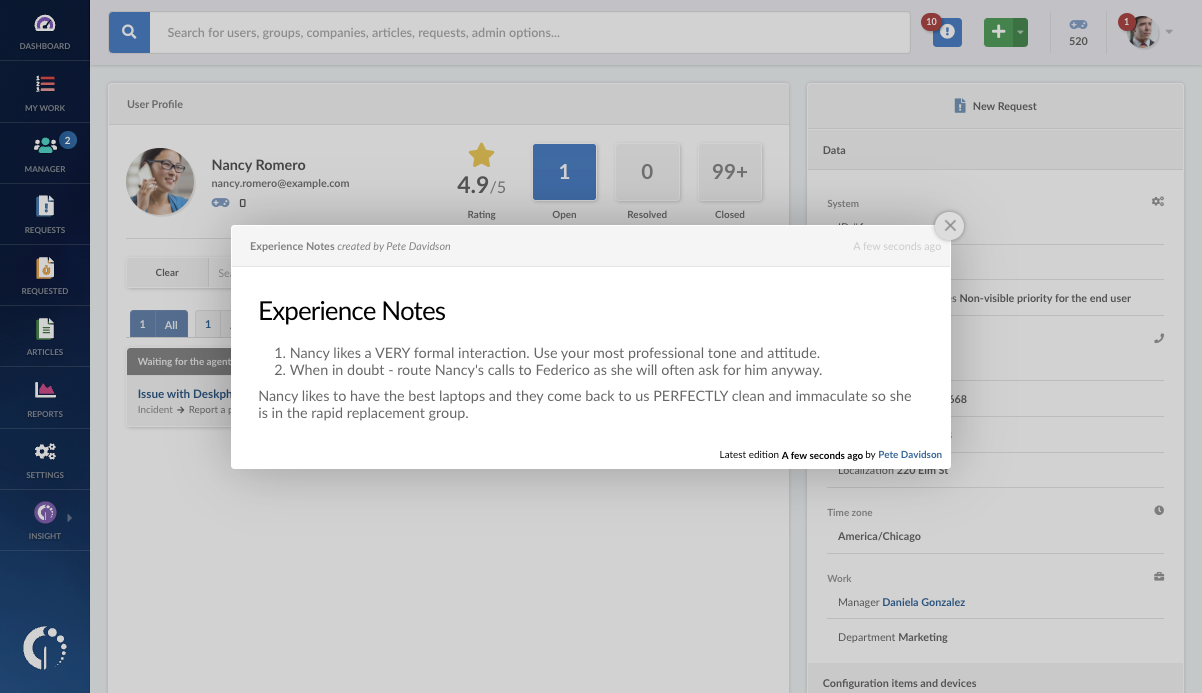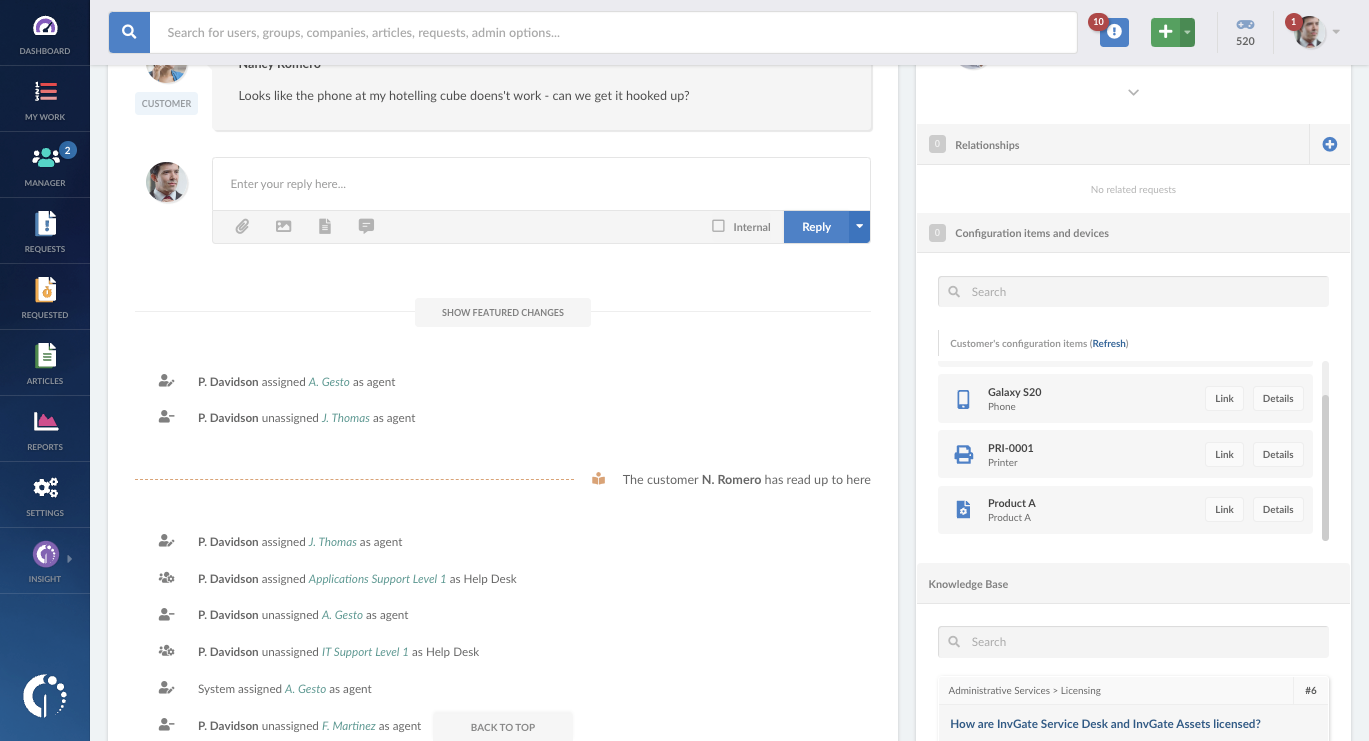"Experience" has become the buzzword for quite some time now. We all think and talk about it, but it hardly ever changes anything. One reason for this is that the word "experience" (and Experience Management, for that matter) is a VERY broad term and can be leveraged for many different outcomes. However, we can take a narrow approach when it comes to service and support by focusing on just one aspect: personalized support.
Have you ever had a conversation with someone and it was obvious they weren't listening? The conversation often reaches a point where miscommunication becomes awkwardly clear – being asked something you already said is the perfect example.
This phenomenon is pretty common when working with customer service and support agents, but it is rarely due to a lack of skilled agents or training. On the contrary, it's the lack of time or permission to access crucial information that typically causes these problems. And they cause discomfort on the other side of the line.
Repeating themselves, listening to scripts, or waiting on hold can make customers or employees feel lonely, distant, or just unimportant. Offering personalized support is a way to avoid all these, and improve your overall experience.
Let's dive into it!
What does "personalized support" mean?
There's no big secret behind the meaning of personalized support. In short, it consists of providing customers and employees with a customized interaction.
One of the most important features of great service is that it is a personal experience. For example, calling "Kathy from Acme" sounds and feels a lot more personal than "Having to call Acme support." Just like a personal conversation, the lack of context and mutual understanding creates distance, discomfort, and generally isn't very enjoyable.
Personalized support is our saving grace, it puts the customer or employee at the center of every interaction. Of course, this isn't unique; it already exists in other business processes like sales, research, and development, to name a few. What we're suggesting is to apply these tactics to service and support because without a personal touch, these business processes can feel sterile and impersonal.

Now, to provide personalized support, you need at least some information. If you work in customer service, you know what it's like when a customer calls in: you get all the relevant information about them, sometimes down to the dollar amount they have spent with your company.
As for IT support, we already have some context of the customer (what devices are assigned to them, and what office they visit the most often, for instance). So how can we take this a step further?
With a change in mindset. Instead of only gathering the customer information that matters to us and our goals or revenue, we can also include in their profile what we should know about them as people. How do they like things shipped to them? Do they have a dog? What music do they listen to? Are they fans of a specific sports team?
Capturing, tracking, and analyzing these seemingly useless data points will give agents power with both customer and employee experiences. The people we work with and serve daily are fantastic, diverse, and complex human beings. In fact, some of the best teams have already been using this information to their advantage.
Benefits and challenges of personalized support
The generalized benefit of personalized support is a better customer and agent experience, but that is just the beginning. With an improved experience, you can expect improvements to:
- Workplace satisfaction
- Employee retention
- Reduced agent turnover
- Customer satisfaction
- First contact resolution
And many of these benefits are the result of making it easier for agents to improve their soft skills and collaborate with each other to truly understand and connect with the people they are serving.
Nevertheless, there are additional challenges you will encounter trying to implement this within your teams.
- How to make this feel authentic
- Capturing the personal details, storing, and presenting them to agents at the moment
- Keeping the cost down
- Training and Organizational Change
- The risk of adding additional personally identifiable information
However, giving your agents the freedom to do this in ways that are organic and natural for them will most likely self-regulate a lot of those challenges.
Why is personalized support important for ITSM?
Personalized support creates a more engaging and meaningful interaction between service providers and users. And people are tired of sterile and awkward business interactions. Even more, 80% of customers think that the experience a company provides is just as important as its products and services.
As companies want to respond to this demand, the ITSM trend is improving experiences and satisfaction. Personalizing service and support is just one way that our teams can contribute to these experiences.
Many teams with experience initiatives or process projects will use visual aids like Journey Maps and Service Blueprints to achieve these goals. And this is certainly one tool that can be used to meet the opportunities and gaps that are highlighted by such initiatives.
The integration of tools such as AI and chatbots for service desks allows for more personalized interactions at scale. They can handle routine inquiries and free up human agents for more complex tasks.
How to provide personalized support
Although this may be simple to describe, let's discuss the many ways personalized support can be executed to improve the experiences your teams deliver.
Small and medium teams
To start, if you're a service desk agent or manager at a small company, or you provide customer service for a limited set of customers, you might already know each person individually. So, it'll be easier to adapt your services and conversations to meet that person's unique needs.
This might mean your agents already ask people about their kids or hobbies while waiting for the computer to restart, or something else that takes time while on the phone or chatting. These extra steps don't just improve the interaction for your customers – it revolutionizes the experience.
Some service desks call this specific kind of personalization "soft skills" — which is basically being able to empathize, connect with other humans, and provide a great service interaction. So, how do we extend and augment customer data to provide agents the power to scale and deliver personalized support on larger teams?
Larger teams
In general, scaling a personalized support experience can be quite difficult. The goal is to right-size your efforts. Provide the opportunity for agents to adapt to the customers' needs without making it sterile, or inauthentic.
Adaptation and flexibility is the most important factor for this type of effort, you cannot script "caring" - nor can you have agents attempting to be someone they are not. Customers and employees will know if agents are not being authentic, which can create distance - the negative experience we were trying to avoid in the first place!
For larger teams, personalized support experiences can be achieved with a planned and strategic effort to add as much context and comfort as possible to every interaction. The benefit of delivering such an experience is that we maintain authenticity, and allow flexibility for agents to do what they do best.
For example, think about that tone-deaf consumer interaction that keeps happening to you. If that organization personalized your experience more, it might stop occurring altogether. I have a friend who has no hair on his head, yet vendors are constantly advertising hair products to him. Imagine all the ways that his context could inform their campaigns! If he walked into a beauty products store, no sales representative would ever suggest hair products to him.
Personalized support examples
Let's walk through a couple of examples of how personalization can improve the consumer experience.
|
|
This dialogue has three points relevant to personalization:
- The IVR (Integrated Voice Response) confirmation was read back as "internet issues." This simple act validates that the system is working as intended, and therefore customers will use and trust the system appropriately in the future.
- Reading the address indicates that the agent has access to the relevant information needed and develops mutual trust and respect.
- Lastly, since this account is marked as "technically savvy because he worked in tech," the agent was able to customize the experience. Even if this were only 70% accurate, or changed recently, I'm known to be a customer good at technical troubleshooting. So, the agent doesn't need to walk me through the script line by line, they are given checklists of things to complete instead of scripted paths to follow.
Here's another personalized support example:
|
|
I like this example because it's much more subtle, yet impactful. Let's say there are 12 pet grooming services in the area, and Miss Baxter would get a better deal if she went somewhere else. But she has a personal connection to this provider because Trixie really does love playing with the other dogs outside. Secretly, Miss Baxter loves that this wears her dog out and truly enjoys herself, that being one of the reasons she books at this location.
So, by mentioning this minor detail, you can keep customers coming back and using your services, with the outcome of reminding owners of the value they already receive, in ways that matter to them.
Creating a database of customer insights: tips and hacks
But you might be wondering how we can acquire, store, and leverage these kinds of insights into what matters for the customer. Well, all it takes is for her to admit that one time to one agent, and have that agent write it in the "notes" for the customer record. This way, we can retain this customer for life (or at least for Trixie's life, in this scenario).
Teams that are hyper-focused on customer and employee experience will find lots of ways to capture, present, and leverage the details that people care about. It all depends on which ticketing or customer systems you use. With InvGate Service Management, you can give agents access to an open-ended way to create notes on the customer’s expectations.

If you're in more of a sales capacity, you might want to show which services they use or have used. If you have on your side a customer view with the products they have (as in the screenshot below), you can imagine how assigning the contracts, devices, and services to the customer can be extremely useful for agents in this context.

Coincidentally, you can also see the groups they belong to, which continues to provide additional context.
All of these are great approaches because they provide the additional context needed for agents and representatives to make informed decisions at the moment. Whether it be providing a better experience, delivering better service, cross-selling, or adapting to personal preferences.
These types of details are one of the ways you can start to influence customer and employee behaviors.
In IT, these use cases are painfully simple. We know so much about people that it's kind of scary. And it doesn't take much effort to provide an incredible experience.
Here are some hacks you could quickly implement to provide personalized support in IT:
- Create open fields where agents can capture notes, and adapt processes and procedures to match. If you have specific needs, you might create specific fields as well. In the case of Miss Baxter, having a field for her pets' names will clearly help.
- Provide agents access to quickly reference which equipment, products, and other services have been purchased or assigned to users, and encourage agents to reference this when working with employees.
- Adapt processes and procedures to accommodate a customized experience for each customer and employee. Changing the standard operating procedures to not only leverage the information, but to capture and update it as well.
- Assign groups of people to similar agents, so that teams in specific departments or geographic regions speak and work with the same agent(s). This creates familiarity in both directions; plus, it makes things easier and fun!
Final thoughts
Aside from soft-skills training, and hiring experienced agents, operationalizing improved experiences is just one way to improve service and provide business value. Even the most mature teams could benefit from having access to these types of information.
Teams should inspect, reflect and update their procedures to meet the needs of the customers, employees, and organizations. Once you visualize, capture, or map the interactions your teams provide, you'll have a better understanding of where the gaps and opportunities exist.
Always improve. This isn't something you do once and forget about. Customizing a truly impactful experience requires persistence, constant care, attention, and support from many levels of the organization.
















